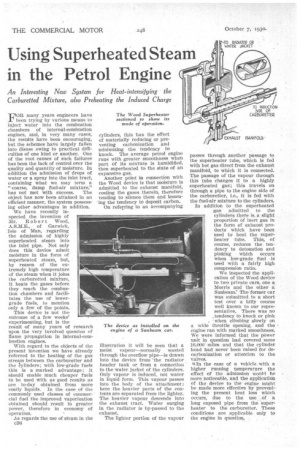Using Superheated Steam in the Petrol Engine
Page 58

If you've noticed an error in this article please click here to report it so we can fix it.
An Interesting New System for Heat-intensifying the Carburetted Mixture, also Preheating the Induced Charge
FOR many years engineers have been trying by various means to inject water• into the combustion chambers of internal-combustion engines, and, in very many cases, the results have been encouraging, but the schemes have largely fallen into disuse owing to practical difficulties of one kind or another. One of the root causes of such failures has been the lack of control over the quality and quantity of moisture. In addition the admission of drops of water or a spray into the inlet tract, containing what we may term a "coarse, damp fuel-air mixture," has not met with success. The object has now been attained in an efficient manner, the system possessing other advantages in addition.
We have recently inspected the invention of Mr. Robert Wood, A.S.M.E., of Garwick, Isle of Man, regarding the admission of highly superheated steam into the inlet pipe. Not only does this device admit moisture in the form of superheated steam, but, by reason of the extremely high temperature of the steam when it joins the carburetted mixture, it heats the gases before they reach the combustion chambers and facilitates the use of lowergrade fuels, to mention only a few of the points.
This device is not the outcome of a few weeks' experimenting, but is the result of many years of research upon the very involved question of flame propagation in internal-combustion engines.
With regard to the objects of the present invention we have already referred to the heating of the gas stream between the carburetter and the Zylinders; with low-grade fuels this is a marked advantage ; it should enable much cheaper fuels to be used with as good results as are to-day obtained from more costly liquids. In the case of the commonly used classes of commercial fuel the improved vaporization obtained should result in greater power, therefore in economy of operation.
As regards the use of steam in the cal cylinders, this has the effect of materially reducing or pre venting carbonization and minimizing the tendency to knock. The average petrol engine runs with greater smoothness when part of its mixture is humidified, then superheated to the state of an expansive gas. Another point in connection with the Wood device is that moisture is admitted to the exhaust manifold, cooling the gases therein, therefore tending to silence them and lessening the tendency to deposit carbon. On referring to an accompanying illustration it will be seen that a moist vapour—normally wasted through the overflow pipe—is drawn into the device from the radiator header tank or from a connection to the water jacket of the cylinders. Only vapour is induced, not water In liquid form. This vapour passes into the body of the attachment; here the heavier parts of the contents are separated from the lighter. The heavier vapour descends into the exhaust tract. Water surging in the radiator is by-passed to the exhaust.
The lighter portion of the vapour passes through another passage to the superheater tube, which is fed with hot gas direct from the exhaust manifold, to which it is connected.
The passage of the vapour through this tube changes it to a highly superheated gas; this travels on through a pipe to the engine side of the carburetter, i.e., it is fed with the fuel-air mixture to the cylinders. In addition to the superheated gas admitted to the cylinders there is, a slight proportion of inert gas in the form of exhaust products which have been used to heat the superheater tube. This, of course, reduces the tendency to detonation and pinking which occurs when low-grade fuel is used with a fairly high compression ratio.
We inspected the appli cation of the Wood device to two private ears, one a Morris and the other a Sunbeam: The former car was submitted to a short test over a hilly course
well known to our repre
sentative. There was no ,tendency to knock or pink . when climbing slowly on a wide throttle opening, and the engine ran with marked smoothness. We were informed that the power unit in question had covered some 16,000 miles and that the cylinder head had never been raised for decarbonization or attention to the valves.
14In the case of a vehicle with a higher running temperature the effect of the admission would he more noticeable, and the application of the device to the• engine might be made more effective by preventing the present heat loss which occurs, due to the use of a long exposed pipe from the superheater to the carburetter. These conditions are applicable only to the engine in question.












































































































